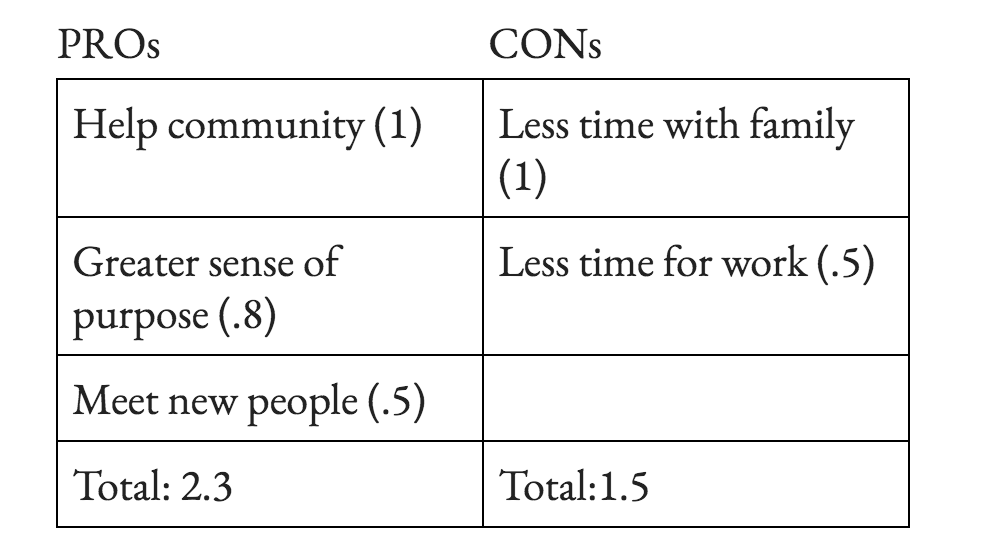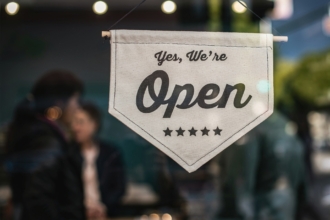A man confides in his friend that he’s having trouble deciding whether to take a new job. The position would provide financial stability but he’d lose his current gig, which is pretty prestigious. Plus, he’d have to relocate with his family.
The man is renowned scientist and theologian Joseph Priestley, and his friend, Benjamin Franklin, offers the following advice: make a list of pros and cons. Franklin instructs him to review the lists and consider their respective weights. Priestley heeded the advice and it led him to accept the position as general assistant to the Earl of Shelburne, where he made historic scientific breakthroughs.
Franklin, a famed polymath and master of self-improvement, shared this counsel in 1772, and since then, the wisdom surrounding decision-making hasn’t advanced much.
Why?
Because there is no hack for making a good decision. Even in today’s global economy, with ever-faster access to information, the fact remains: important choices require the same careful deliberation as they did in the 18th century.
But, that doesn’t mean we can’t come up with strategies for making the process more efficient and increasing the odds of being satisfied with our decisions.
As CEO of Jotform, I make hundreds of choices each day, some with few consequences, others with lasting import. Here are some expert-backed tips that I’ve found helpful for making smarter decisions.
1. Let go of ‘perfect’ and aim for ‘good enough’
If you’ve ever gone grocery shopping at the end of a long day, then I’m sure you’ll agree: we don’t always make great choices when we’re tired. At 7 pm in Whole Foods, that jumbo tub of chocolate-covered raisins seemed like a good idea.
This “decision fatigue” happens when we spend too much time mulling over options, and according to experts, it prevents us from making smart choices in many contexts. In the New York Times, author John Tierney writes:
“Decision fatigue helps explain why ordinarily sensible people get angry at colleagues and families, splurge on clothes, buy junk food at the supermarket and can’t resist the dealer’s offer to rustproof their new car.”
What’s more, when we expend too much mental energy on decision-making, we might even double down on bad choices. Tough deliberations can be unpleasant and when the facts clash with our ultimate decision, it creates cognitive dissonance — to reduce that mental discomfort, we find a way to justify our decision. That’s why a smoker might reason that smoking isn’t healthy, but at least it stops him from overeating.
The implications are clear: we can benefit from reducing the time spent on decision making and preventing mental fatigue.
So, what’s the solution?
Let go of perfectionism and settle for good enough. There’s no such thing as a perfect decision. Every option has a potential flaw, so focus on finding a useful, applicable alternative, not the perfect one.
Not to mention, while you’re wasting time on deliberating, your competitors are advancing. As LinkedIn co-founder Reid Hoffman put it:
“If you’re not embarrassed by the first version of your product, you’ve launched too late.”
2. Combine intuition with expertise
Following your intuition. Trusting your gut. Call it what you will, listening to that inner voice can prove invaluable.
Consider Stanislav Petrov, a lieutenant colonel in the Soviet Air Defence Forces. In 1983, with the Cold War still simmering, Petrov was alerted that five U.S. missiles were heading towards the USSR. Acting on what he later called “a funny feeling in my gut,” Petrov reported it to superiors as a false alarm. As it turned out, he was right — the missiles had launched accidentally. And because of Petrov’s intuition, a nuclear war was likely avoided.
Importantly, research shows that intuition is more effective when the decision-maker has in-depth knowledge. Petrov wasn’t a rookie. His experience led him to believe that had the U.S. launched an attack, it would have been way more extensive than five missiles.
Decision-makers can also acquire in-depth knowledge using data. At Jotform, our latest product, Jotform Report Builder, aims to give users the kind of clear data visuals to back up (or refute) any gut feeling. These automatically generated reports are easily digestible, so you can quickly make insights, and shareable, too. Armed with knowledge about how users interact with your website, you can support your intuition without wasting time explaining the report itself.
And again: less time deliberating leads to more efficient, better choices.
3. Create a value-based pros and cons list
Franklin may have been the first proponent of the pro/con list, but he wasn’t the only great thinker to utilize this technique. Charles Darwin left behind a now-famous list of pros and cons about one very significant life choice: whether to get married (spoiler alert: in Darwin’s case, the pros outweighed the cons).
Sometimes, all of the pros and cons are available, but it’s hard to evaluate which side should prevail without putting pen to paper — so draw a vertical line and start listing. To make it more methodical, go one step further and assign values (0 to 1) to each item, based on your personal values and goals.
For example, if you’re thinking about volunteering at a food shelter, a snapshot of your list might be:
Then add up your lists. There might not be a perfect decision, but creating value-based pros and cons lists can assist you in finding the better one overall.
4. Try negative visualization
What went wrong?
That’s the question that Harvard Business Review contributor Gary Klein recommends asking about a project — before you even begin.
The reasoning is simple: research has shown that imagining an event has already occurred increases our ability to identify the reasons for possible outcomes by 30%. In other words, if we imagine all the things that could happen, we have a better understanding of why they do.
If, as Klein writes, we imagine all of the reasons that a project may go awry, then we can identify potential issues in advance and pick up on them faster should they arise.
What’s more, this negative visualization technique can help us to overcome decision paralysis. Imagining the worst-case scenario and considering how we’d handle it can remove the teeth from fear of failure.
In today’s rapidly evolving market, it falls on business leaders to make smart choices. While a perfect decision may be unrealistic, a better, more efficient process is within reach. Sometimes it’s just a matter of putting yourself in the best position — drawing upon experience, data, and a thoughtful list — to choose wisely.















Send Comment: